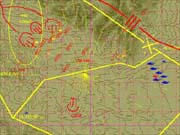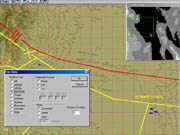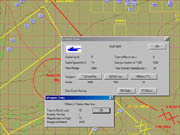Now that we aren't living in the Dark Ages, many ordinary people have the desire and the free time to engage in leisure-time activities that in other circumstances could be considered work. BCT (which stands for brigade combat team) Commander is perhaps the best tool yet devised in the "work as fun" philosophy of modern-day slacking off. Rating BCT Commander's merits as a game is almost a pointless exercise, because for a number of military professionals, it's not. It's their job, or one significant part of it. Or at least it's a simulation of someone doing one aspect of his or her job. So whether or not you enjoy it is, in a sense, completely irrelevant. However, unlike a simulation of, say, public accountancy, this job lets you order tanks around, call in air strikes, and blow things up. Thanks to its uncompromising simulationist perspective, BCT Commander makes this both more and less fun than it sounds.
This release is actually a sort of "gold pack" consisting of an upgraded version of the original BCT, two expansion packs, and a scenario editor. The first BCT was a little light on scenarios (it only shipped with 11), but given the reduced price of the product, it was a reasonable deal. The current edition comes with 57 scenarios, as well as the ability to edit them and create your own.
The game itself plays out in real time, although with the ability to pause or compress time. Units have order paths assigned to them, and they follow these plots until ordered to do otherwise. You can assign artillery fire missions, air strikes, infantry mounts and dismounts, and wire and minefield clearing and watch your units perform these tasks in real-time. There is a fair amount of micromanagement involved, although there are some nice features built in as SOP (standard operating procedure) choices, like the ability to set maximum engagement range, engage on contact automatically, and dismount infantry on contact, as well as other shortcuts like the ability to copy and paste unit paths from one group to another. It feels a bit like a land-based version of Harpoon, especially in the way that you never quite know what the enemy has up his or her sleeve.
Sometimes, you may not be sure what you have up your sleeve, either. One of the most notable things about BCT Commander is that there is a significant time investment required just to set up each scenario. The first time we tried to play, we had to print out the OPORD (operations order) and study it for almost an hour (in conjunction with examining the map) just to know what was expected of us. There are a number of useful hints, like the fact that organizational boundaries, sector responsibilities, and even enemy objectives can be displayed on the map, but for those not at least generally familiar with wargames, figuring out how to begin can be fairly daunting. Even for those with extensive experience with military simulations, just starting a scenario can be a lot of work.

Rather than an algorithmic AI, the game employs one of several predetermined strategic approaches to each scenario in planning its strategy. This means that, to some extent, enemy actions are scripted, although this refers to general battle planning and not to the individual unit-to-unit combat. This kind of opposition means that you'll eventually see the AI reveal all its cards, at which point there's not much left to do but try to optimize your responses. There are plenty of scenarios, though, and by the time you've beaten the AI in all of them, you'll probably be tired of the game, or in the Army.
The scenarios themselves are a bit disappointing, in that many of them take place on US Army training grounds with opponents like the "Krasnovian Army," rather than historical or hypothetical scenarios with more interest for wargamers. There is one interesting Golan Heights scenario from the 1973 Yom Kippur War, and some hypothetical Korea and Ukraine scenarios as well, but it seems like a missed opportunity to have an engine this "realistic" yet not provide some historical situations where you might actually gain some insight into the reasons for a particular outcome or plausible situations that never happened (such as NATO vs. Warsaw Pact operations). With the availability of satellite terrain data, this could have been that much more interesting. There are some interesting Kuwait and Afghanistan scenarios, at least. One drawback is that you can't always play as the OPFOR (opposing force), probably due to the need to script AI for the friendly force in such a case.
As you might have inferred by now, the learning curve for BCT Commander is extremely steep. In fact, the game manual makes the point that "army officers train their whole lives to fight wars and still get their butts kicked by the OPFOR at places like the National Training Center at Fort Irwin, California." That's not a very encouraging thought for those struggling to get a handle on how to deploy their FASCAM (that's family of scatterable mines). If you're not the type of person who's comfortable talking about an OPORD or SITTEMP (situational template), or you don't immediately know which side would win if five rectangular boxes with ovals in them attacked five rectangular boxes containing the letter "X," you'll find the learning curve to be a straight line oriented at 90 degrees to your computer desk. That's not to say you won't like it, because you very well may. It will simply take a lot of effort to find out.

The interface makes good use of the mouse for context-sensitive menus, but it tends to rely on these a bit too much. Clicking on an obstacle allows you to type in an orientation for it, but there is no way to simply rotate a minefield with the mouse. There is no hotkey to take you directly to artillery fire mission planning. A good keyboard-and-mouse combination can go a long way toward making an interface easy to use, and unfortunately BCT Commander makes too much use of the standard Windows menu and shortcut system. It's understandable, but it is also one of the game's notable shortcomings.
Unlike many so-called independent publishers, Shrapnel Games does a decent job of at least trying to provide printed documentation, and BCT Commander's manual is even better than Shrapnel's standard. It's the type of manual than can be read as a narrative rather than as a set of legal pronouncements, and it's especially helpful in providing answers to questions like "Why doesn't this work?" Like a recalcitrant Linux installation, BCT Commander can sometimes appear to be malfunctioning when it really isn't. Sidebars in the manual like "Why Can't I Breach an Obstacle" and "Why Can't I Mount a Unit" help head off frustration when the game seems to be behaving abnormally. Maybe your AVLB (armored vehicle launched bridge) has already breached, and thus can't breach again. It's worth considering, anyway.
Some shrewd design choices on the part of the developer keep the game from devolving into arcane abstraction. Although units on the map can be represented by military symbols, the scale is small enough that they don't have "centers of gravity" or similar devices that make these kinds of military planning games seem artificial at a larger scale. Each tank symbol represents one to three vehicles, and tanks still fight it out with direct fire and get blown up by minefields that you can see. It's this tangible aspect of combat that makes the game feel like a game, and while there could be more visual feedback (wrecked tanks are designated by an "X" rather than by a flaming wreck animation, for example), BCT Commander keeps the focus on the battlefield in a way that captures your attention.

Shrapnel Games boasts that BCT Commander has full-color maps, but this is really more of an assurance that the black-and-white maps from BCT have been upgraded than a selling point in itself. The maps are rather plain, and they are drawn with contours, which can take quite a bit of getting used to for those not familiar with them. There is a nice line-of-sight tool that displays which parts of the map are visible from a given point, but for the uninitiated it's a very different way of seeing terrain, and adding vegetation to the equation makes line of sight even more problematic. The upside is that once you become accustomed to them, you'll be able to get the lay of the land in any scenario with a bit of careful map study. However you look at it, the game isn't particularly pretty. Nor is it meant to be.
BCT Commander is in many ways an outstanding product that delivers exactly what it claims to--it's a rigorous, realistic simulation of what it's like to command a brigade of combined-arms troops in modern warfare. The real question is whether you're interested enough in the subject matter to devote what will realistically be dozens of hours before you can become reasonably proficient with the game. Some wargamers may justifiably be turned off by its lack of established wargame conventions. On the other hand, you may find in BCT Commander a refreshing return to the way war really is--or at least how you perceive that it is from the brigade commander's perspective.